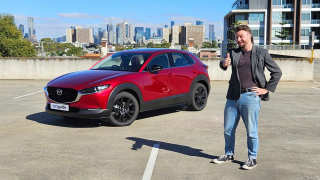
How to use a roundabout | video
Hands up if you were taught to give way to your left on a roundabout, or if you were told to give way to your right. Now, put them up if you were told to indicate when leaving a roundabout, even if you're travelling straight through. And finally, and just to really confuse matters, who was told you definitely don't need to indicate unless you're turning left or right?
Right, so that's just about everyone, then? Well, we've got some bad news for you: everything we thought we knew about how to use a roundabout is wrong.
Born of the considerably older circle junctions, the modern roundabout exploded in popularity across the UK in the 1960s, because they not only allowed traffic to merge without coming to a complete stop, but because they lowered the severity of any accidents that might occur by significantly reducing the speed of a collision, and by making head-on collisions almost impossible.
Over the next 50-odd-years, they popped up everywhere (France alone has somewhere in the vicinity of 30,000), but ask even the most confident driver to explain the complex web of rules that govern their use, and you'll be met with the blank and nervous stare of someone who has no idea what they're talking about, but is about to start pretending.
And that's partly because we've been handed down dodgy advice, and partly because roundabout rules vary from state to state. To further muddy the murky waters of understanding, you've got dual-lane roundabouts, multi-lane roundabouts (be they three-lane or four-lane) and the so-rare-it's-almost-mythical double roundabout (there's one planned for Adelaide) to navigate, too.
So it's time to forget what you think you know about how to use a roundabout, and consider the below your official guide to the Australian roundabout rules.
Australia-wide roundabout rules
Give way
Contrary to popular belief (or at least what our dads always told us), the simple rule of right-of-way on a roundabout doesn't favour traffic to the left or to the right. Instead, every state dictates that anyone entering a roundabout has to give way to any vehicle that is already on it, regardless of their position.
Turning left or right
If you're using a multi-lane roundabout and you want to turn left, approach in the left-side lane and indicate appropriately. If you want to turn right, do the exact opposite. Using a single-lane roundabout is no different, except it all happens from the same lane.
Making a U-turn
On a multi-lane roundabout, stay in the right-hand lane and indicate right, keeping your indicator on until you reach your exit. The rules are the same on a single-lane roundabout, but your lane selection is made for you.
Driving straight ahead
There is no need to indicate as you approach the roundabout, but you should follow the road markings or street signs to ensure you're in the correct lane. Whether or not you have to indicate when you exit the roundabout depends on which state you live in.
Roundabout rules NSW
First up, there are two roundabout signs used in NSW. The first is the yellow diamond, which simply means there's a roundabout ahead. The second is the white upside-down triangle, and that one means you need to give way to cars on already on the roundabout. The last option is a Stop sign, which, unsurprisingly, means you have to stop at the unbroken white line before entering the roundabout.
When it comes to indicating, NSW rules simply state you need to signal for long enough for the drivers around you to know what you're going to do. But one of the great myths that needs to be busted is that you do (or don't, depending on what you've been taught) need to indicate when exiting the roundabout, even if you're travelling straight through. In NSW, that rule reads that you should only indicate on exiting "when practical to do so". In other words, it's largely up to you.
Roundabout rules QLD
The roundabout rules in Queensland largely mirror those of NSW, but with one critical difference that could cost you money and demerit points if you're not across it.
Unlike NSW, QLD rules state that you must use your indicator when you're leaving a roundabout, even if you're travelling straight through. Wait until you've passed the last exit before the one you want to take before signalling your intention to leave the roundabout.
Roundabout rules WA
Western Australia's roundabout rules mirror those in Queensland, so you'll be indicating on the approach to the roundabout if you want to turn left or right, and indicating once you've past the last exit before the one you're taking if you're travelling straight ahead.
Roundabout rules VIC/Roundabout rules SA
Victorian roundabout rules match those in NSW, meaning it's once again up to you whether or not you indicate to exit the roundabout if you're simply travelling straight through. It's the same in South Australian, so once again you only need to indicate on exiting a roundabout "when practical."
Roundabout rules Tasmania
Tasmanian rules match those in Victoria, NSW and South Australia, except you now need to watch road lines. A dotted line at the entry to the roundabout means give way, while an unbroken line means you need to come to a complete stop.
Roundabout rules Northern Territory
It's back to indicating when leaving the roundabout, even when travelling straight through. Otherwise, though, the rules are straightforward: to turn left, use the left lane and indicate accordingly. To turn right, do the same but in the right lane. Or do both from the centre of your lane if there's only one in use. But always give way to any vehicle already on the roundabout.
Roundabout rules ACT
Canberra roundabouts are governed by the "halfway around" rule, meaning if you intend on leaving the roundabout before the halfway point, then enter using the left lane and indicate left before you enter the roundabout. If you plan on leaving it after the halfway point, then enter using the right lane. If you plan on going straight through, then there is no need to indicate.










Comments